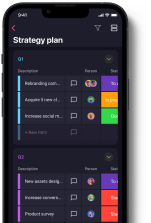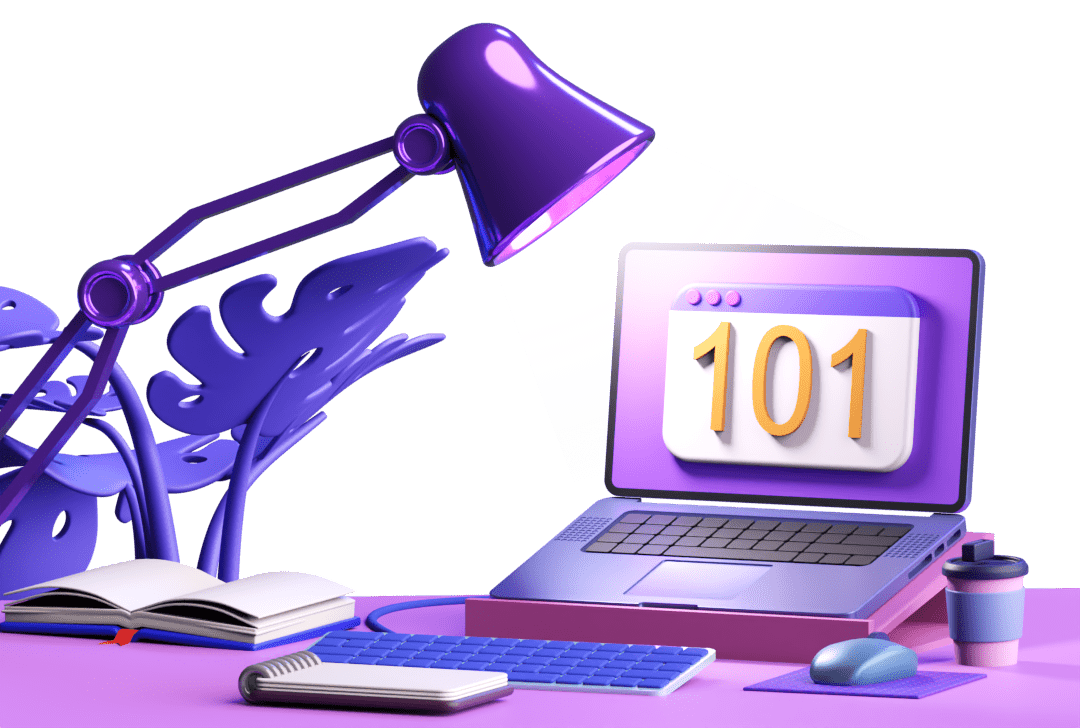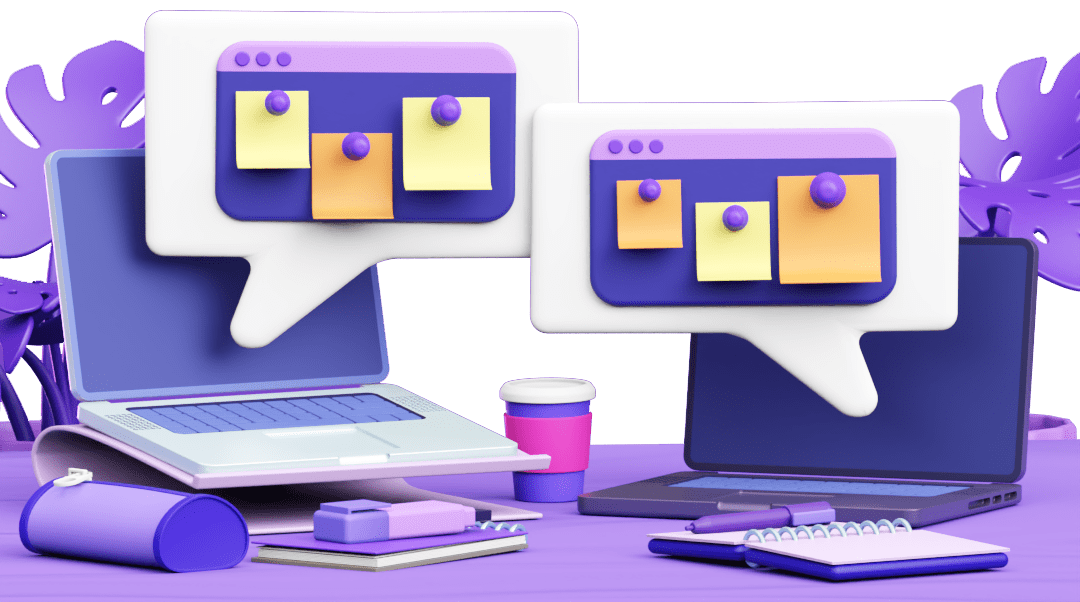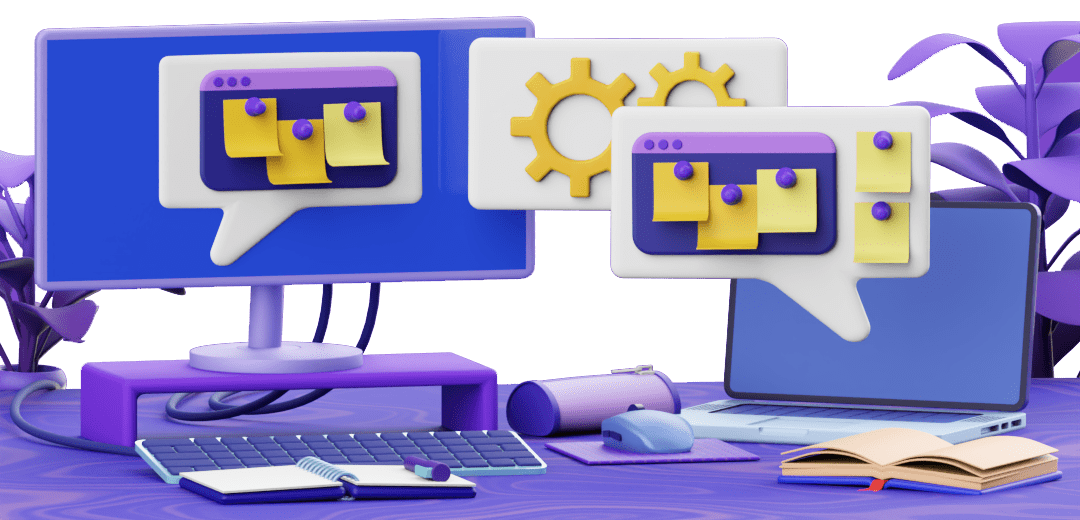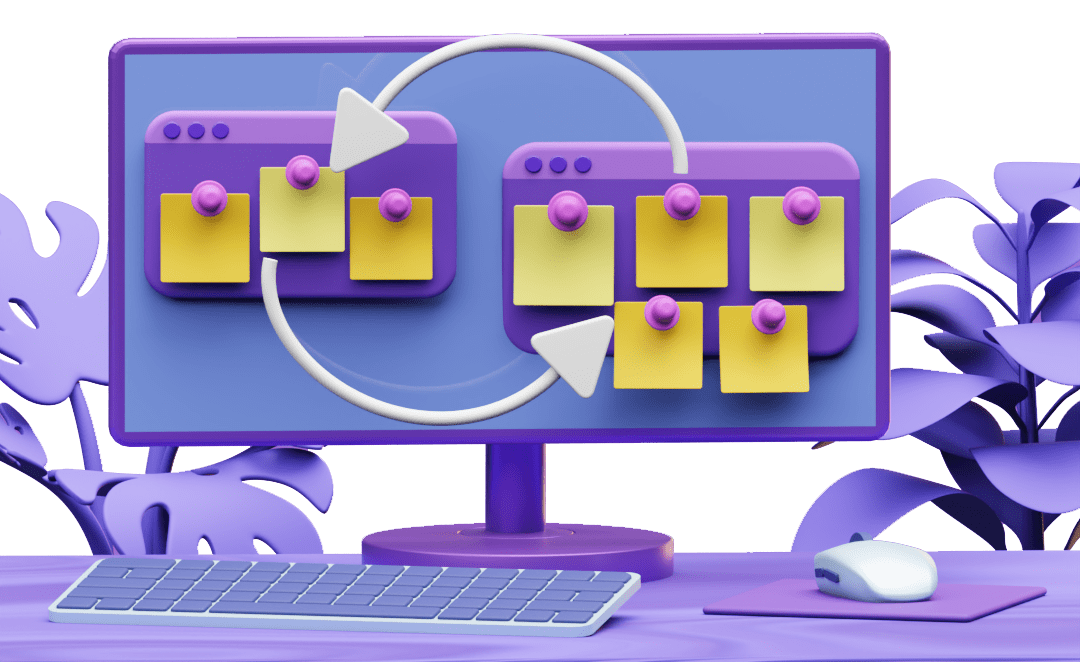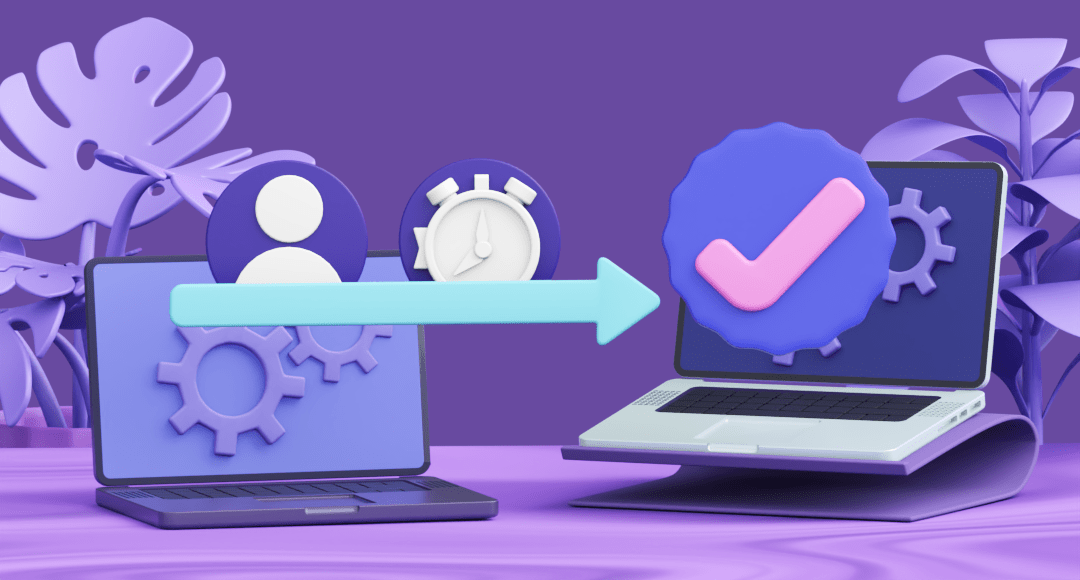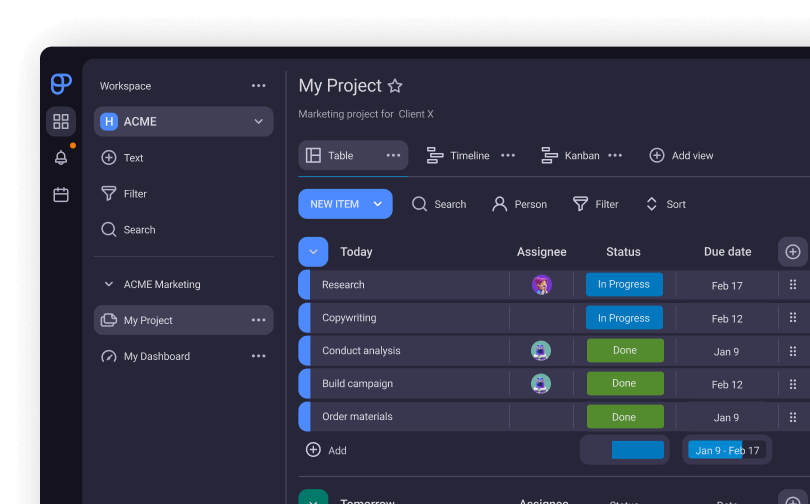What Is Waterfall Project Management?
Not every project manager wants to keep going back and forth while completing a project. For some, good project management boils down to doing all the research beforehand and safely navigating through carefully planned phases.
Waterfall is the poster boy for predictive project management methodologies. Featuring a wholly leaner and sequential approach to completing projects, it’s the ideal method for larger ventures with well-defined goals and requirements.
In this guide, we’ll go over everything you need to know about the Waterfall project management methodology, including:
- How it works and when to use it,
- The 5 Waterfall phases,
- Its advantages and disadvantages,
- How you can implement it in your projects,
- The difference between Waterfall and other PM methodologies, and
- What happens if you combine it with Agile to get a hybrid PM approach.
Let’s start!

Table of Contents
What is Waterfall and how does it work?
Waterfall is a linear project management approach whose phases follow a logical finish-to-start sequence.
Waterfall is all about making a detailed and thorough project plan and then sticking to it. The order in which the project tasks are done is also important and cannot be fiddled with.
Due to this sequential nature, Waterfall is also highly resistant to change and revision. According to Elizabeth Harrin, APM Fellow, author of Managing Multiple Projects, and the expert behind Rebel’s Guide to Project Management, changing anything in a Waterfall project doesn’t come cheap:

“Predictive methods rely on you having a pretty clear idea of where you are going. There is always room for change, but in the Waterfall world, it tends to be more expensive and difficult to incorporate because of how the solution is built.
For example, when we did large-scale software projects, incorporating changes became tricky towards the end as it was difficult to regression test. We’d already written a lot of documentation about how we wanted the system to work, and it had been built to meet those needs. Adding extra bits in later wasn’t impossible, but we did try and push them into a future phase if possible.”
Different PM methodologies cater to different types of products or different industries. Waterfall has its roots in construction and manufacturing, where project phases need to happen sequentially.
If your project is to build a house, and you’re now placing roof tiles, it’s impossible to go back and change the foundation or rearrange the plumbing pipes. You could do it, but it would mean undoing all the work that came after and starting over.
This is why the planning phase of a Waterfall project has to be so thorough. It’s also the main reason it’s difficult to make changes after the project gets underway.
However, there can be some wiggle room sometimes. For instance, if you’ve already painted the walls, changing the electrical wiring in the walls may also require you to undo some of the work, but not all of it.
When is it appropriate to use Waterfall project management?
We asked Elizabeth Harrin for her insights on Waterfall and its use in project management:

“I was trained in the predictive (Waterfall) life cycle when I first started out managing projects. It’s a method that I have found works really well in a matrix environment, where you are pulling in various subject matter experts for short pieces of work, and where the goals are known.”
According to her, matching your project’s needs to the method is essential:

“The higher the level of uncertainty, the more you need to be flexible. If you’re building a car park, and you’ve made your career building car parks with other people who also build car parks for a living, you have [a] high degree of predictability. You don’t need to iterate or prioritize features for that. [But] if you are evolving a product to meet market needs based on incoming customer feedback, you would benefit from being iterative and incremental.”
Before the advent of Agile, Waterfall was the de facto methodology to use for software development. However, despite many companies still preferring to use Waterfall for IT projects and software development — it may not always be a good idea.
According to a paper on the use of the Waterfall model in large-scale software development, the methodology suffers from a few dire issues related to verification and requirements.
The case study examined the use of Waterfall at Ericsson AB in Sweden and identified multiple problems that hinder large-scale software development. As a result, the company moved onto a more agile, incremental approach.
Example of Waterfall project management
Construction and manufacturing are obvious candidates for Waterfall. Here’s what Jan Schiller, Partner and Chief Project Officer at Berkshire Consulting LLC, has to say about choosing Waterfall for a certain type of project:

“Waterfall is indicated when the result is critical and when a minimum viable product cannot be achieved other than with the expected result. For example, Waterfall is absolutely indicated for a project building a bridge, and Agile does not apply. The minimum viable product is the completed bridge that safely allows vehicles and pedestrians to move across. Because of laws of physics, a specific engineered design is essential.
Waterfall is also indicated when requirements are clear and tolerance for failure is necessarily low (for example, building the international space station or a robot surgeon). Many methodologies are indicated for software development. The required expertise is to know which one to apply given the circumstances.”
Essentially, an ideal project for Waterfall often ticks all or most of these requirements:
- The client knows exactly what they want,
- The project needs to follow a linear trajectory,
- The project deadline and scope are contractually negotiated,
- It’s possible to estimate the project timeline,
- The timeline, budget, and scope are fixed,
- The project is too risky to commit to without a solid plan, and
- The project doesn’t allow for iteration.
The 5 Stages of Waterfall
When you think of a waterfall, you usually imagine a single stream of water cascading from a precipitous height. But that’s not the image Waterfall is trying to evoke.
So instead, try to imagine a small stream of water that makes several smaller cascades, as if running down a staircase. After every step, the water levels off for a bit before facing the next plunge.
This is the imagery that correctly depicts the Waterfall PM methodology — a single project moving in one direction, divided into 5 Waterfall project phases:
- Requirements,
- Design,
- Implementation,
- Verification, and
- Maintenance.
Until you end a stage, you cannot start the next one. And, as mentioned, backtracking to the previous stage isn’t an option either.
Some sources divide this methodology into 6 or even 7 stages. However, that needlessly complicates matters.
With that in mind, let’s go over the 5 stages of Waterfall one by one.

Stage #1: Requirements
The first stage of Waterfall is mostly conceptual. The goal here is to understand what the client wants.
To accomplish this, the project manager gathers important information about the project and its requirements through brainstorming, interviews, questionnaires, or any similar methods.
To get the best out of this requirements-gathering stage, the project manager includes the client and all key project stakeholders in the process.
If done properly, completing the Requirements stage of Waterfall gives you an exact idea of not only the scope but all the project deliverables too.
For example, if the project involves remodelling someone’s bedroom, you should know exactly how the room should look and what it should contain by the end of this stage.
💡 Plaky Pro Tip
Learn more about requirements gathering and the techniques you can use in our guide:
Stage #2: Design
The Design stage is still mostly planning-oriented. The difference is that the PM can now work with their team to analyze the project requirements and create a comprehensive plan.
Essentially, if the 1st stage is all about the “what”, the 2nd stage of Waterfall explains the “how”.
The plan you come up with will stay in use until project completion, so it must cover all bases to ensure a successful finish. So, you use this stage to discuss the information you got in the previous one and figure out how you will take the project from start to finish.
For example, if the project entails building a house, the project team would use this stage to decide on the materials — quality and quantity.
A detailed, well-polished project plan and overall documentation are a must before you move on to the next step. Therefore, get ready to stay in this phase for as long as it takes to complete. Waterfall rewards but also demands patience.
Stage #3: Implementation
The Implementation stage is where you complete almost all of the non-conceptual work.
To follow up on the construction example given above, this is where the team would take the materials and use them to build a fully functional house.
This seems like it should be the most complicated stage, but there isn’t much to say about it.
If the documentation compiled throughout the Requirements and Design stages is up to par, the Implementation stage should be smooth sailing.
Stage #4: Verification
The Verification stage — also known as the testing stage — is when the team has to verify whether the end product works as intended and meets the requirements.
This stage also marks the first instance of client involvement and feedback since the conceptual phases of Waterfall. So, in the case of a construction project, such as building a whole house, this stage would entail checking it against safety standards.
Know, however, that if you encounter major problems, you might have to go back to the drawing board, i.e., stage 1. If the product is not up to standard and doesn’t fulfill all expectations, that shows a lack of proper, detailed planning.
If not, you can work out the kinks, get the client’s seal of approval, and deliver the final product or service.
Stage #5: Maintenance
The Maintenance stage is self-explanatory.
Typically, it involves routine maintenance, but at times, it may also include resolving small issues that pop up from time to time.
Overall, the main focus of Waterfall is carefully planning out and executing these 5 stages. As Waterfall projects are often complex, you can always rely on project management software to keep an eye on your project’s progress with ease.
Here’s how you could depict the Waterfall stages in a tool like Plaky:

The advantages of Waterfall
We have already touched on many of the advantages of using Waterfall, but let’s go into greater detail here. Essentially, Waterfall:
- Makes it easy to measure progress,
- Suits repeatable projects well,
- Helps with setting manageable expectations,
- Easily resists scope creep, and
- Maintains easy knowledge transfer between stages.
Advantage #1: Makes it easy to measure progress
Thanks to its linear structure and clearly defined start and end points of each stage, gauging a project’s progress in Waterfall is quite easy.
With many other methodologies, the team spends a lot of time throwing things at the proverbial wall to see what sticks. Even then, since the project doesn’t progress in a linear manner, it can be hard to tell exactly how far along it’s come.
Granted, a good project manager should always have a solid idea of how the project is coming along.
But with Waterfall, it’s easy to clue stakeholders in on the progress by referring to the project milestones. Once you determine which ones you’ve achieved, you can evaluate the timeline and ensure you’re on the right track to delivering the project within it.
In addition to making it easy to measure progress, Waterfall is overall easy to understand and doesn’t require much training. The use of Gantt charts, in particular, can provide amazing insight into the project structure and the rate of project completion at a glance.
One of the experts we talked to, David O’Brien, PMP-certified founder of TheProjectManagement.Expert, highlights Waterfall’s easy-to-understand nature as well:
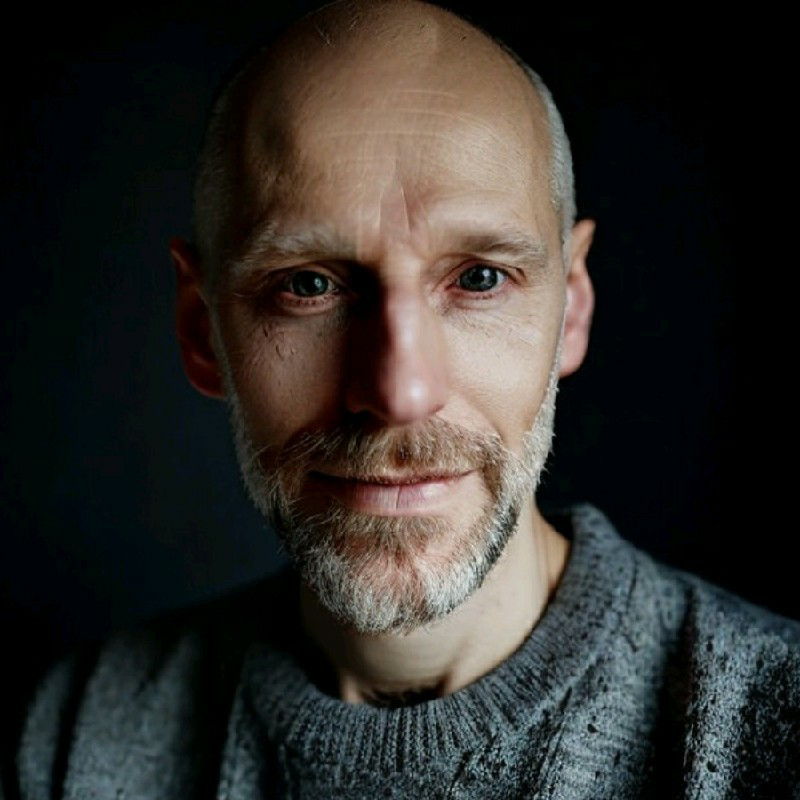
“Waterfall allows me to manage large complex projects in a very structured manner. It lends itself to being reported on in an almost universal manner that is understood by nearly all business people without further context. It allows me to control the delivery of the project, utilizing multiple teams with a great level of predictability. [And] through the output of the Gantt chart and a higher level project timeline, it provides a visual focal point that is the basis of communicating scope and progress, no matter what culture or languages are involved in the project.”
Advantage #2: Suits repeatable projects well
The extensive documentation you compile throughout a project’s life cycle doesn’t go in the trash on project completion. Instead, you can archive it for future use.
And when the time comes to do a similar project, you can use the old documentation as a reliable repository of knowledge. That way, you can better anticipate risks, set milestones, determine the necessary project resource utilization, and so on.
In other words, if you’ve completed a project using Waterfall once, every subsequent attempt at a similar project becomes that much easier.
This also means that knowledge stays in the organization, rather than with the individual. And that leads us to the next pro.
Advantage #3: Helps with setting manageable expectations
During the Requirements stage, the project manager and the client need to come to an understanding of what the project will be like. They negotiate and contractually define everything about the project, including the cost, timeline, scope of the project, and project goals.
With well-defined requirements, it’s easier to define the expectations too — and keep scope creep at bay.
The advantage is that you do all the planning in Waterfall at the beginning, and deviation is a no-go.
This makes it much easier to determine the right budget and estimate a manageable project timeline — something any client with limited resources and a tight schedule would appreciate.
Advantage #4: Easily resists scope creep
Contractual limitations aren’t the only thing keeping scope creep away from Waterfall projects. Scope creep is one of the most prominent project risks, but Waterfall — due to its very nature — isn’t susceptible to it.
In Agile project management, continuous client involvement and iterative development can quickly balloon the project scope beyond the initial capacity.
But Waterfall makes for a rather stable approach where outcomes are predictable and problems are easy to foresee.
Waterfall projects are all but set in stone the moment implementation starts. This methodology does not support backtracking and redrawing plans to accommodate scope expansion.
In other words, if the client changes their mind and decides they want something else, you may be able to arrange it. However, it may have to be a new project that starts over from ground zero.
Advantage #5: Maintains easy knowledge transfer between stages
Comprehensive documentation is the name of the game when it comes to the Waterfall methodology.
This documentation details the specific roles, responsibilities, and requirements of each team member, as well as all the necessary information about the project and its deliverables.
So, adding new team members or replacing existing ones often goes smoothly, without slowing the pace of the project to a crawl. Since it’s easy to pass information from one stage to the next, the rookies get to be in the know from the very start.
In contrast, projects that rely on other methodologies — especially iterative ones — make it harder to integrate new team members. They generally take longer to get comfortable and build confidence in such scenarios. Naturally, this can impact the project’s progress in the long term.
The disadvantages of Waterfall
Waterfall has found its footing in many industries. Still, its roots in construction and manufacturing shaped its identity.
In the end, this has given it several disadvantages you may not be able to avoid. When followed as prescribed, Waterfall:
- Demands detailed client input,
- May succumb to timeline creep, and
- Suffers from a lack of feedback.
Disadvantage #1: Demands detailed client input
Speaking of providing input, a serious concern for any Waterfall project is that the client may not know exactly what they want early in development.
It’s not uncommon for clients to give the project manager a general idea, see how things start turning out, and only later in development get a better picture of what they want and don’t want.
With Waterfall, however, the client needs to know, in great detail, exactly how they want the end product to be. Meanwhile, the project manager has to understand how to turn these comprehensive requirements into the end product.
If the project is short-term or not too complex, providing these requirements may not be a huge issue. However, it can be a challenge with long-term, large-scale projects if clients don’t know or cannot articulate what they want.
In the end, the margin for error the PMs have to work with is minuscule. So, if the Requirements stage goes wrong, the entire project will shake on this weak foundation.
Disadvantage #2: May succumb to timeline creep
Just because you have a great project plan doesn’t mean that everything will go as expected.
Even with amazing risk management in place, setbacks are not an unusual occurrence in projects.
Unfortunately, Waterfall projects suffer more from these setbacks than those following most other methodologies. And it all boils down to the sequential and linear nature of Waterfall.
In Waterfall, you cannot begin work on a new phase before finishing the current one. For example, you cannot add windows to a house until you’ve put up the walls.
In practice, this means that a delay in any phase has the potential to delay the entire project. And for projects with a strict deadline, this can be disastrous.
Disadvantage #3: Suffers from a lack of feedback
Using Waterfall is not unlike a trust exercise.
The client helps the project manager understand exactly what the requirements of the project are. However, after that, they don’t get to see anything or give their feedback until the Verification stage.
Quality assurance comes later in the process — and that’s far too late for certain projects, such as software development.
Waterfall also has a natural resistance to revision. So, if something about the project isn’t to the client’s liking, making changes would be difficult — and often quite costly.
Since the stages are sequential, mid-project pivots and shifts are tough to implement, as they may require a do-over of all the previously made components.
In other words, feedback would come too late in the development process. Therefore, if there are any issues — serious losses are all but unavoidable.
How to implement Waterfall in project management
Everything we’ve mentioned so far makes it clear that Waterfall — like all other project management methodologies — best suits a certain kind of project.
Once you’ve found the right project, it’s time to implement the Waterfall model. To do this, you have to follow the Waterfall stages carefully and complete the project activities each of them entails.
Here’s a more detailed insight into the implementation of Waterfall in project management.
Step #1: Research and get granular with the project requirements
The first step in the process is to kick off the Requirements stage. This stage starts with high-level planning and slowly becomes more granular as the requirements become clearer.
It’s vital to be as accurate as possible in this stage. Comprehensive documentation of all the requirements and other project details is a must.
In this stage, you have to do lots of research and analyze the data to gain more insight into what the project is all about. You also must meet with the stakeholders and hear them out. Their insight is the backbone of the project.
One of the experts we’ve talked to, David O’Brien, has given us a full breakdown of the activities he completes in a Waterfall project. In the Requirements stage, they are as follows:

- “Build the business case,
- Determine the feasibility of the project,
- Review the product-market fit,
- Scope the requirements,
- Break down the requirements into a Work Breakdown Structure (WBS),
- Document every assumption [and] test these assumptions with the project stakeholders, [and]
- Document every risk in a Risk Register [and] start to review how to mitigate those risks.”
According to David O’Brien, the project sponsor typically starts to ask questions about the duration of the project during this stage. In that case, he provides them with a Rough Order of Magnitude (ROM) estimate.
After that, he continues with other activities, such as:

- “Seek out the Single Point of Contact (SPOC) for the project. If none is forthcoming, then I immediately put a stakeholder matrix and communication plan together. Otherwise, I leave this analysis until a later phase, [and]
- I have a conversation with the project stakeholders to determine the project success criteria. I solidify this information using the SMART method to define SMART Goals.”
💡 Plaky Pro Tip
Interested in learning more about project assumptions, the types that exist, and how to manage them to ensure project success? Read our guide below:
Step #2: Create a schedule and plan the project in detail
The main focus of the Design stage is to interpret the findings from the previous one and create detailed specifications. Most importantly, your customer’s expectations serve as guidelines here and ultimately help the project reach a satisfactory end.
This stage involves planning any steps and activities you have to take part in to get to the finish line. For David O’Brien, the start of the Design stage involves these 2 activities:

- “Move the WBS into a project scheduling tool [and] create the project schedule, [and]
- Estimate using PERT, [which] is great because it doesn’t pin a person to a single estimate — everyone feels much more comfortable applying a range of estimates.”
Right after that, David O’Brien starts planning the project using the critical path method.

“Initially I plan based on teams and assign tasks to the teams. Later, during this phase, I will secure and assign named people to those teams, and assign tasks to those specific people based on their skill sets.”
Continuing the Design stage, he also completes the following activities:

- “Determine task dependencies,
- Review Critical Chain (people dependencies),
- Level the resources (if the software provides this capability), [and]
- Determine the multiple project milestones. These will be added frequently within the project and will be used as part of earned value management during the later phases, in order to confirm that the project is on track.”
Once he produces the project schedule, David O’Brien may turn to Gantt charts. According to him, it is useful to “abstract the Gantt chart into a project timeline for easier review by senior management.”
As he inches closer to the end of the Design stage, David O’Brien goes through a few more activities:

- “The product design documents, guidelines, [and] figmas are produced here,
- The quality management strategy is created, [and so are] the test plan and test cases,
- The communication plan is updated along with the stakeholder plan,
- Status reports start to be produced and are stored in the central project repository, and
- The RAID log (Risk Register, Action Log/Assumptions, Incidents, Dependencies/Decisions) is continually updated.”
Finally, if he finds it would be beneficial, David O’Brien may also conduct a pre-mortem in this stage.
💡 Plaky Pro Tip
The initial stages of Waterfall mention the creation and updating of a communication plan. But how important is communication in project management anyway, and is there a way to make it more effective? Read all about it in the guide below:
Step #3: Dive into the work
After all the conceptual work and planning, it’s time to roll up your sleeves and get your hands dirty. The Implementation stage is all about creating the end product.
As David O’Brien puts it, “At this point, the majority of the project artifacts are created, and the activities revolve around the management of the project and the people.”
The activities he lists in the Implementation stage are as follows:

- “1:1 meetings take place,
- Resource management takes place,
- The project is tracked against the project schedule, [and] the project schedule is updated as required,
- Risks are reviewed weekly, [as] mitigating action may need to be taken,
- Issues are tracked and can be mitigated,
- The project is reported on as per the communication plan, and
- Project status meetings [and] project governance meetings and/or steering committees take place.”
If it’s a software development project, David O’Brien adds another activity to this list — setting up the production environment.
Step #4: Keep testing and resolving issues
The main focus of the Verification stage is quality assurance.
You will have been conducting tests throughout the project stages to make sure the outcomes match the client’s expectations. In this stage, you have a chance to carefully review and resolve any issues.
According to David O’Brien, this is the time when “the project is verified against the project design documents.”
Using software development as an example, he also lists the following activities as a part of the Verification stage:

- “Code deployments to higher environments take place,
- System integration testing may take place,
- User acceptance testing takes place,
- Production testing takes place,
- Environment and Software Penetration Testing (PEN Testing) takes place, [and]
- Go-live.”
Step #5: Provide top-notch support and maintenance
The final stage includes formally ending the project and maintaining what you created.
Most projects don’t actually end with delivery, especially if the outcome was software.
In fact, in some industries, the Maintenance stage may last indefinitely. You may need to provide long-term support for your products — at least as long as stipulated in the contract.
Depending on the type of project, the arrangements, and other similar factors, the Maintenance stage may include:
- Keeping a close eye on any bugs or issues,
- Providing software patches or other kinds of replacements and updates,
- Proactively improving the product to increase user satisfaction, and
- Replacing services or products with newer versions.
According to David O’Brien, the final stage of a Waterfall project usually includes the following activities:

- “Celebrate,
- Lessons learned/Post-mortem takes place,
- Project handover to a Run team takes place,
- Finances and billing is initiated, [and]
- A stabilization period is started and finished.”
💡 Plaky Pro Tip
The final stage in Waterfall includes a post-mortem — a post-implementation review of the project’s performance. Learn why it’s an important part of any project and how to conduct it in the guide below:
What is the difference between Waterfall and other methodologies?
All project management methodologies fall into these 2 groups:
- Predictive methodologies — where you predict the workflow and outline the project as much as you can and follow the plan carefully, and
- Adaptive methodologies — where you break the project down into smaller chunks as you go along and incrementally adapt it based on changing requirements and feedback.
The biggest differences between Waterfall and other methodologies all stem from this division.
Waterfall vs Agile project management
According to the Agile Manifesto, the 4 key values of Agile are:
- Individuals and interactions over processes and tools,
- Working software over comprehensive documentation,
- Customer collaboration over contract negotiation, and
- Responding to change over following a plan.
Waterfall completely inverts this list of values and makes it so that:
- Processes are respected,
- Documentation is irreplaceable,
- Contract negotiation is crucial, and
- The plan is key.
Some of the major characteristics of Agile project management include:
- Self-management — no need to rely on the project manager’s guidance,
- Cyclical approach — a higher level of stakeholder involvement makes Agile projects more flexible and capable of providing quick turnover, and
- Quick start — Agile projects don’t have to be planned to the tiniest details.
Detailed planning — or a lack of it — was found to be one of the main differences between these 2 methods in a study on how to choose between Agile and Waterfall.
Another important difference is how the work plays out.
Whereas Waterfall projects require a clearly outlined project execution plan that handles few revisions, Agile is less strict in that department.
With Agile, you focus more on transparent communication and short feedback cycles. That way, you ensure customer satisfaction and bring the project to a satisfactory close.
This may make Agile more enticing. However, the Australian Institute of Project Management highlights 2 rather important disadvantages of Agile to keep in mind:
- Since the project scope of Agile projects isn’t clearly outlined at the start, Agile teams that aren’t so familiar with the approach may not know what to focus on, and
- Too much flexibility may cause other problems in the organization if the changes and shifting priorities aren’t properly communicated and managed.
Still, the success rate of Agile projects is high despite some of its shortcomings. Data shows that Agile projects are 3 times more likely to succeed than their Waterfall counterparts.

Waterfall vs Scrum
Strictly speaking, Agile is not a project management methodology but rather a set of values. You need to follow these values to be Agile, but there aren’t any exact steps you should follow to manage a project using Agile.
This is where Scrum, one of the project management frameworks built on Agile, comes into play.
Some of the other famous Agile frameworks include:
The Scrum framework, however, seems to be the most popular agile approach.
All of these frameworks can provide you with a basic plan on how to manage projects using Agile. The differences between Waterfall and Scrum are practically the same as the differences between Waterfall and Agile.
For instance, Scrum handles development and testing by dividing projects into smaller development cycles — Sprints. These usually last only a few weeks, and at the end of each Sprint, you have a potentially releasable product.
Additionally, in Scrum, you have a backlog of tasks that don’t need to be done in sequential order. The Product Owner is the one who prioritizes these tasks. Meanwhile, a cross-functional team of Developers tackles each increment.
According to a comparative analysis of traditional and agile SDLC models, Scrum also differs from Waterfall in that:
- It is value-based and deals with the product and the people, not the project and the process,
- Its focus is on collaboration, team creativity, and high customer involvement,
- It is suitable for smaller teams working in a dynamic environment, and
- It admonishes detailed planning and documentation.
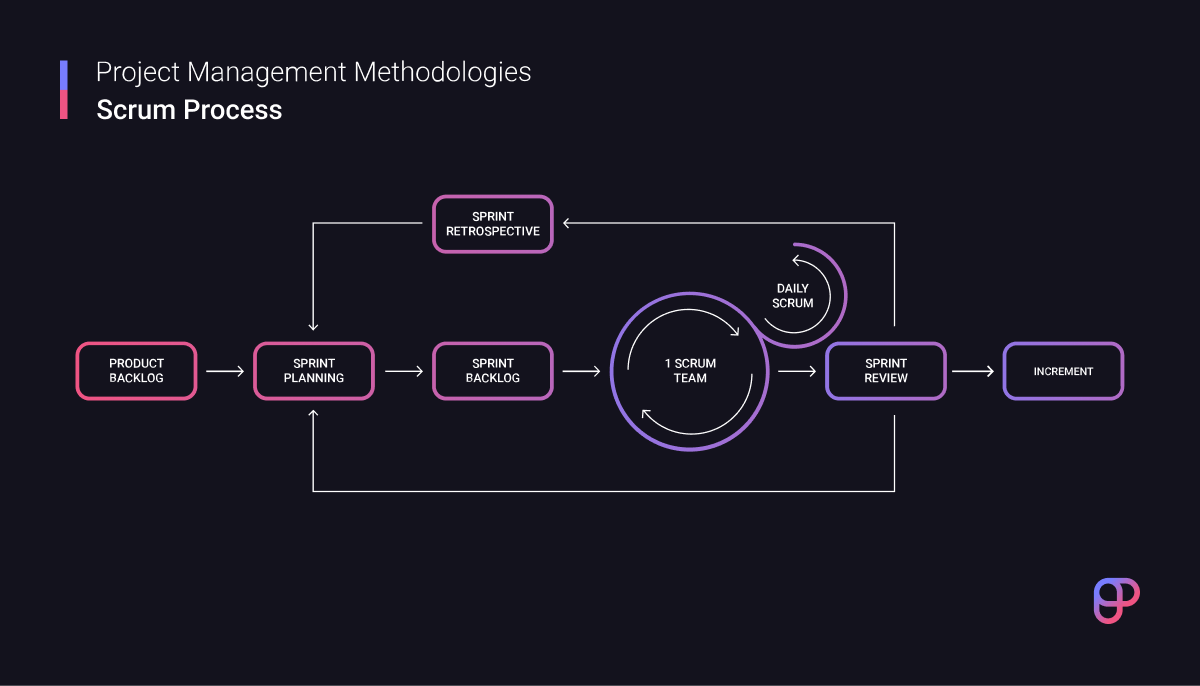
💡 Plaky Pro Tip
For a more in-depth comparison of Scrum and Waterfall, check out the following guide:
What is Agifall or Wagile?
If you prefer the more detailed planning of Waterfall and the iterative, non-sequential project workflow of Agile, you can use a mixture of both. This is known as a hybrid methodology — Agifall or Wagile.
According to an article on the application of hybrid approaches in project management, one of the main advantages of a hybrid approach like Agifall is that it resolves a key drawback of Waterfall — resistance to change.
The gist of this hybrid approach is that you take what’s good from Waterfall — the solid planning — and remove the bad parts — the lack of extensive QA during the implementation stage.
The end result is a project management methodology that still operates off of a solid foundation, but gets going quicker than traditional Waterfall. Moreover, it delivers value in smaller increments, all of which go through quality assurance.
Some other reasons project managers may opt to use a Waterfall-Agile hybrid approach are:
- Enhanced team collaboration,
- Project-specific customization,
- Chance to reassess projects mid-development,
- Slow but steady transitioning to Agile project management, and
- Need for faster development within a predetermined set-in-stone project budget and timeline.
One of our experts, Jan Schiller, highlights how common hybrid approaches are in project management:

“I am passionate about delighting stakeholders by helping them get from where they are to where they want to be in the shortest amount of time and [with] the least amount of money with the highest quality solution. A hybrid approach to delivering a solution is, in reality, likely the most common.”
Talking about the pros of using a hybrid approach like Agifall, she lists the following:

“The advantages of a hybrid approach are numerous, largely realized by defining the best path to a result that meets or exceeds expectations. Customizing any methodology is required because one size rarely fits all projects, even for projects within the same organization. For example, procuring resources (software, hardware, resources, etc.) involves contracting and is not suited to an agile approach (the expected result is very specific and delivering less or different is not an option).”
As for the cons of using hybrid approaches, Jan Schiller highlights these 2 drawbacks:

“One disadvantage of combining methodologies can be the extra time required to deliver the result when an organization’s governance is inflexible, resulting in too many hurdles for exceptions to the pure application of a single methodology. Another disadvantage of combining Waterfall and Agile is failing to understand that Agile is a software development approach designed to mitigate risks associated with vague requirements and/or a rapidly changing solution space. Too often, organizations confuse Agile with time-boxed Waterfall, or iterative delivery, or incremental delivery.”

Conclusion: Waterfall helps you plan for a predictable triumph
At a glance, Waterfall may seem too traditional and strict for modern project management. If anything, it requires lots of patience and careful planning — not ideal for the hectic modern world.
But different project management methodologies cater to different types of projects — and the same goes for Waterfall.
This guide’s purpose was to help you learn about the pros, cons, and specific requirements of this methodology. Now, you should be able to discern whether your project can benefit from it and which steps to take to make it a success.
📖 Now that you’ve read everything you need to know about Waterfall project management, go a step further — check out our Project Management Glossary of Terms to get familiar with project management terminology.
References:
- Petersen, K., Wohlin, C., & Baca, D. (2009). The Waterfall Model in Large-Scale Development. Lecture Notes in Business Information Processing, 386–400. https://doi.org/10.1007/978-3-642-02152-7_29
- Comparing Traditional Systems Analysis and Design with Agile Methodologies. The Traditional Waterfall Approach. (n.d.). Retrieved April 10, 2023, from https://www.umsl.edu/~hugheyd/is6840/waterfall.html
- What is a Gantt chart? APM. (n.d.). Retrieved April 10, 2023, from https://www.apm.org.uk/resources/find-a-resource/gantt-chart/
- Manifesto for Agile Software Development. Retrieved April 10, 2023, from https://agilemanifesto.org/
- Thesing, T., Feldmann, C., & Burchardt, M. (2021). Agile versus Waterfall Project Management: Decision model for selecting the appropriate approach to a project. Procedia Computer Science, 181, 746–756. https://doi.org/10.1016/j.procs.2021.01.227
- Agile vs Waterfall: What’s the Difference? AIPM. (2022, July 27). Retrieved April 10, 2023, from https://aipm.com.au/blog/agile-vs-waterfall-whats-the-difference/
- Mersino, A. (n.d.). Why Agile is Better than Waterfall (based on Standish Group Chaos Report 2020). Vitality Chicago Inc. | Agile Training, Coaching & Transformation. Retrieved April 10, 2023, from https://vitalitychicago.com/blog/agile-projects-are-more-successful-traditional-projects/
- Than, Myint. (2020). A Comparative Analysis of Traditional and Agile SDLC Models for Software Development. DOI:10.13140/RG.2.2.10769.45923
- Copola Azenha, F., Aparecida Reis, D., & Leme Fleury, A. (2020). The Role and Characteristics of Hybrid Approaches to Project Management in the Development of Technology-Based Products and Services. Project Management Journal, 52(1), 90–110. https://doi.org/10.1177/8756972820956884
- Rough Order of Magnitude definition. Law Insider. (n.d.). Retrieved April 11, 2023, from https://www.lawinsider.com/dictionary/rough-order-of-magnitude
- What Is a Stakeholder Matrix? (With a Template and Example). Indeed. (n.d.). Retrieved April 11, 2023, from https://www.indeed.com/career-advice/career-development/stakeholder-matrix
- Raid Log. Corporate Finance Institute. (2022, December 13). Retrieved April 11, 2023, from https://corporatefinanceinstitute.com/resources/management/raid-log/
 Project Management Hub
Project Management Hub 

